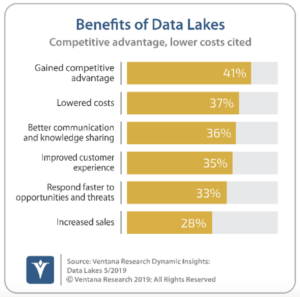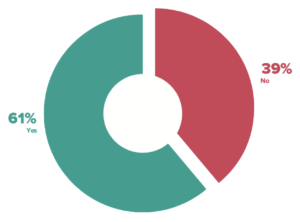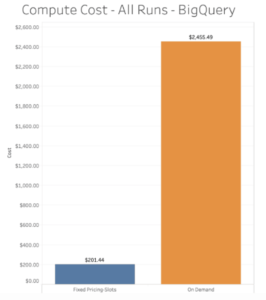
Big Data is a Competitive Advantage
Big data plays a critical role in modernizing analytics. Analytics are conducted at a much more granular level than ever before because we can capture and save much more data than ever before. As a result, organizations are using more data in more ways to get a leg up on their competition. In fact, in a recent Ventana Research survey, they learned that the number one benefit of big data is gaining a competitive advantage.

Ventana’s Research shows that not only are organizations gaining a competitive advantage, but they are using big data to lower costs, improve customer experience, respond faster to opportunities in the market and to increase sales.
Data and Analytics Are Moving to the Cloud
A recent survey performed by AtScale, Cloudera and ODPI.org showed that 61% of the data and analytics professionals surveyed are operating data platforms in the public cloud. This is in line with Forrester’s research that shows that currently, 65% of North American enterprises rely on public cloud platforms.
Do you currently operate data platforms in the public cloud?

Of the 39% of respondents who indicated that they are not on the cloud at all, 48% plan to deploy a public cloud data warehouse/platform in the future, 16% said that they plan to stay off the cloud, and 36% are still evaluating their options.
Do you plan to deploy cloud data platforms in the future?

In Ventana Research’s paper, “Making Big Data Valuable:Embracing a Modern Architecture for Analytics in the Cloud”, they say that “As organizations embrace the cloud for big data systems, it will be important to acknowledge challenges present in the current cloud-based models. For instance, many cloud providers utilize consumption-based billing, which makes it difficult to budget and manage costs since usage may vary in any given monthly billing cycle. Accessing large volumes of data also increases the cost of utilizing cloud-based platforms, and periods of high concurrency with many users accessing the system can create both performance and cost challenges.”
Things You Should Know When You Move to the Cloud
AtScale quantified the scalability boundaries for the most popular cloud data warehouses – Google BigQuery, Amazon Redshift, and Snowflake – both with and without AtScale. Using the standard TPC-DS (10TB) benchmarking framework, we set out to test the performance and scalability boundaries of the various options. In addition, we also examined the operational cost dimension and we challenged the traditional data modeling techniques by testing an alternative to raw TPC-DS SQL. The chart below shows that on-demand pricing may be unpredictable and is tough to manage but reserved pricing has a higher fixed cost ($10k/500 slots).

There’s no doubt that enterprises can get tremendous value out of big data on the cloud which can only be realized when the data is analyzed. AtScale offers a new approach to cloud data analytics for any enterprise that needs to manage massive data sets, simplify data engineering and gain access to live data for business insights. AtScale Adaptive Analytics helps business users make data-driven decisions quickly, easily and securely.
For more information:
-
Read Ventana Research’s paper “Making Big Data Valuable:Embracing a Modern Architecture
-
Watch the “How Distributed, Dynamic and Diverse Data has Transformed Big Data Analytics” on-demand webinar


SHARE
The Practical Guide to Using a Semantic Layer for Data & Analytics